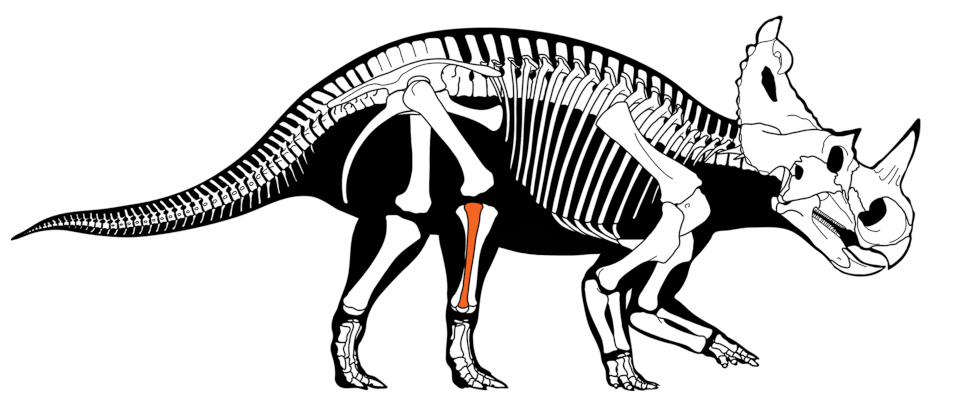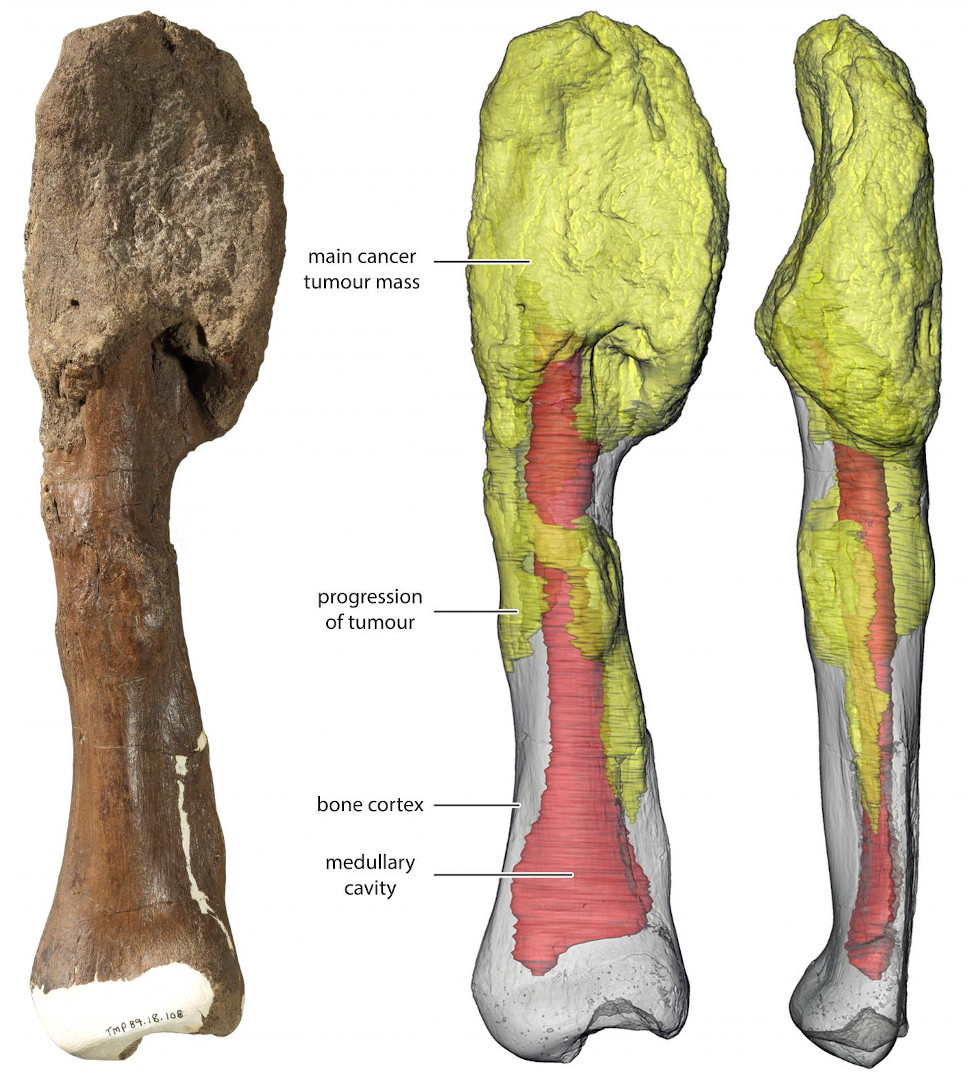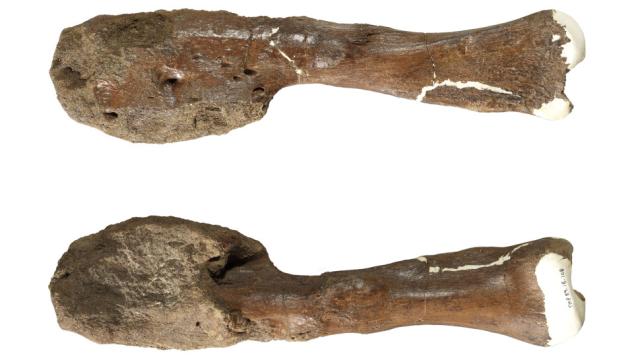A re-analysis of a shin bone belonging to a horned dinosaur from the Cretaceous period has revealed signs of a malignant tumour, in what’s considered a first for dinosaur paleontology.
Back in 1989, paleontologists in Alberta, Canada, unearthed a 76-million-year-old fibula, or lower leg bone, belonging to Centrosaurus apertus, a four-legged dinosaur from the Cretaceous. Curiously, however, this femur was badly deformed, but scientists didn’t give it much thought, believing the malformation to be caused by a healing fracture.
The fossil came back into focus in 2017 after David Evans, the chair of vertebrate paleontology at the Royal Ontario Museum (ROM) and an associate professor at the University of Toronto, along with colleagues, noticed the strange features when viewing the fossil at the Royal Tyrrell Museum of Paleontology in Drumheller, Alberta.
Evans’s co-author, pathologist Mark Crowther from McMaster University, had previously predicted that dinosaurs probably got cancer, but he wondered why a convincing case hadn’t yet been found.
“I said that our best shot to find dino cancer was to go to the Royal Tyrrell Museum collections and search through their large holdings of pathological dinosaur bones,” said Evans. “My team recognised that the malformed bone was unusual for a break and needed a closer look.”
Thus began a unique multidisciplinary effort to re-analyse the fossil, a project that included ROM paleontologist Louise Temerty and osteopathologist Snezana Popovic, also at McMaster, which is located in Hamilton, Ontario. The results of their analysis were published today in Lancet Oncology.

Centrosaurus apertus was a four-legged ceratopsian, or horned dinosaur. Reaching some 5.5 metres long, these beasts featured a long horn on their snouts and a short frill adorned with four horns, the top two of which were quite small. As the new research shows, this particular dinosaur, and probably others, were not immune to cancer, specifically osteosarcoma, a serious bone malignancy.
For their analysis, the team evaluated the fossil in a manner reminiscent of how a tumour would be diagnosed in a human patient. The scientists took CT scans of the fossil and examined thinly cut sections under a microscope, which allowed for a cellular-level view of the specimen. Digital 3D modelling tools allowed them to reconstruct the progression of the disease as it ravaged the dinosaur’s femur.
All evidence pointed to advanced-stage bone cancer, but to make sure, the researchers compared the diseased fibula to a healthy version taken from another Centrosaurus apertus fossil, and also to a human fibula with a confirmed case of osteosarcoma. This comparative analysis further affirmed the diagnosis.
“Most cancers are manifest in soft tissues and are very unlikely to fossilise, making this particular specimen very special,” said Evans. “This is the first confirmed case of a malignant cancer in a dinosaur, and one of the only positive diagnoses of this type of horrible disease in the fossil record.”
To which he added: “This remarkable and very rare find shows that no matter how big or powerful some dinosaurs may seem, they were affected by many of the same diseases we see in humans and other animals today, including cancer.”

When asked if something other than a malignant tumour could account for the deformations seen on the fossil, such as the fossilisation process itself or gradual deformation of the fossil over time, Evans said it’s unlikely, as the bone’s physical characteristics cannot be attributed to any aspect of the fossilisation process.
“The cancerous bone is severely malformed, with a massive gnarly tumour larger than an apple in the middle of the bone,” he said. “In fact, the top half of the bone is missing, and it may have broken in life due the progress of the cancer.”
The CT scans, plus the super thin sections, exhibited the hallmark signs of osteosarcoma on the bone tissue. They showed that the tumour had spiraled through the cortex of the bone, ruling out the original identification of a healed fracture, Evans explained.
With its leg and possibly other bones and organs ravaged by cancer, this dinosaur was likely in bad shape.
“The bone cancer in this dinosaur is at such an advanced stage that it may have spread to other body tissues, such as the lungs, and it’s badly malformed shin would have affected its mobility,” said Evans. “This particular Centrosaurus was likely weakened and lamed by the cancer prior to its death, and likely would have been in pain and slower than it otherwise would have [been.]”
That said, Evans and his colleagues don’t believe the dinosaur died from the disease, as its femur was found in a massive bonebed; this dinosaur, along with many of its herdmates, was probably killed and buried after being washed away in a flood. It’s possible that life in a herd saved it from opportunistic carnivores; hampered by the tumour, the animal would have been particularly vulnerable to predators, including the fearsome tyrannosaurs that prowled Cretaceous Alberta.
This unique finding should now inspire paleontologists to revisit other fossils, which, like this one, may have been originally misinterpreted. It also connects us to dinosaurs in an unexpected way.
“Dinosaurs can seem like mythical creatures, but they were living, breathing animals that suffered through horrible injuries and diseases, and this discovery certainly makes them more real and helps bring them to life in that respect,” Evans said.
